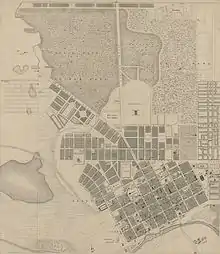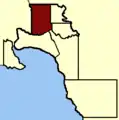| Melbourne Victoria—Legislative Assembly | |||||||||||||||
|---|---|---|---|---|---|---|---|---|---|---|---|---|---|---|---|
_2022.svg.png.webp) Location of Melbourne (dark green) in Greater Melbourne | |||||||||||||||
| State | Victoria | ||||||||||||||
| Dates current | 1856–1859 1889–present | ||||||||||||||
| MP | Ellen Sandell | ||||||||||||||
| Party | Greens | ||||||||||||||
| Electors | 54,533 (2022) | ||||||||||||||
| Area | 25 km2 (9.7 sq mi) | ||||||||||||||
| Demographic | Central Metropolitan | ||||||||||||||
| Coordinates | 37°48′14″S 144°56′28″E / 37.80389°S 144.94111°E | ||||||||||||||
| |||||||||||||||
The electoral district of Melbourne is an electorate of the Victorian Legislative Assembly. It currently includes the localities of Docklands, Carlton, Melbourne, East Melbourne, West Melbourne, North Melbourne, Parkville, Newmarket, Kensington and Flemington, and includes Melbourne University. The district has been in existence since 1856 (it was abolished in 1859 and reestablished in 1889).

The electorate was won in 2014 for the first time by Greens candidate Ellen Sandell.
History
Melbourne was one of the inaugural districts of the first Assembly in 1856.[1] Its area was defined by the 1855 Act as:
Commencing at a Point in the Yarra Yarra River due South from the South-western Angle of Gisborne Street, thence to Gisborne Street, and by the Western Side of that Street to Victoria Parade, thence by the South Side of Victoria Parade to the Western Side of Nicholson Street, thence by the said Western Side of Nicholson Street Northwards to the Boundary Line of the Corporate Limits of Melbourne, thence by the last-mentioned Boundary Line bearing West to the Moonee Ponds, by the said Moonee Ponds downwards to the Site of Main’s Bridge,[a] thence by a Line bearing South to the Yarra Yarra River, and on the South by the Yarra Yarra River to the commencing Point.[1]
- a now Flemington Bridge
Melbourne was abolished in 1859, its area was split into the new electoral districts of East Melbourne and West Melbourne, each having two members.[2]
Melbourne was re-created as a single-member electorate by the Electoral Act Amendment Act 1888[3] which took effect at the 1889 elections.
Since 1908 the seat had been traditional Labor territory since 1908, but had become increasingly marginal against the Greens since 2002. Senior Labor minister Bronwyn Pike successfully held the seat against strong Greens challenges at three subsequent elections, defeating future Greens Senator Richard Di Natale in 2002 and 2006, and prominent lawyer Brian Walters in 2010. Pike resigned in 2012, and Labor candidate and City of Melbourne councillor Jennifer Kanis retained the seat after a closely contested by-election, which saw her finish second on primary votes to Greens candidate Cathy Oke but win on preferences. Kanis lost the seat to Greens candidate Ellen Sandell at the 2014 election. Along with the seat of Prahran it was the first win for the Greens in the Victorian Legislative Assembly.
Members
| First incarnation (1856–1859, 5 members)[4] | |||||||||||||||||||
|---|---|---|---|---|---|---|---|---|---|---|---|---|---|---|---|---|---|---|---|
| Member 1 | Party | Term | Member 2 | Party | Term | Member 3 | Party | Term | Member 4 | Party | Term | Member 5 | Party | Term | |||||
| Archibald Michie | None | 1856–1859 | David Moore | None | 1856–1859 | John Smith[5] | None | 1856–1859 | William Stawell | None | 1856–1857 | John O'Shanassy[6]# | None | 1856 | |||||
| James Service | None | 1857–1859 | Henry Langlands | None | 1857–1859 | ||||||||||||||
| Second incarnation (1889–present, 1 member) | |||
|---|---|---|---|
| Member | Party | Term | |
| Godfrey Carter | None | 1889–1900 | |
| Edward Findley | Labour | 1900–1901 | |
| James Boyd | Ministerialist | 1901–1908 | |
| Alexander Rogers | Labor | 1908–1924 | |
| Tom Hayes | Labor | 1924–1955 | |
| Labor (Anti-Communist) | 1955–1955 | ||
| Arthur Clarey | Labor | 1955–1972 | |
| Barry Jones | Labor | 1972–1977 | |
| Keith Remington | Labor | 1977–1988 | |
| Neil Cole | Labor | 1988–1999 | |
| Bronwyn Pike | Labor | 1999–2012 | |
| Jennifer Kanis | Labor | 2012–2014 | |
| Ellen Sandell | Greens | 2014–present | |
Election results
| Party | Candidate | Votes | % | ±% | |
|---|---|---|---|---|---|
| Greens | Ellen Sandell | 15,855 | 37.3 | −1.3 | |
| Labor | Rebecca Thistleton | 13,033 | 30.6 | −5.1 | |
| Liberal | George Palackalody | 7,522 | 17.7 | +0.3 | |
| Victorian Socialists | Colleen Bolger | 2,323 | 5.5 | +5.5 | |
| Reason | Nicola Foxworthy | 1,601 | 3.8 | 0.0 | |
| Animal Justice | Rabin Bangaar | 701 | 1.6 | −0.3 | |
| Family First | Michael Janson | 535 | 1.3 | +1.3 | |
| Freedom | Steven J. Smith | 521 | 1.2 | +1.2 | |
| Ind. (Indigenous-Aboriginal) | Laylah Al-Saimary | 428 | 1.0 | +1.0 | |
| Total formal votes | 42,519 | 96.6 | +1.3 | ||
| Informal votes | 1,485 | 3.4 | −1.3 | ||
| Turnout | 44,004 | 80.7 | +0.1 | ||
| Notional two-party-preferred count | |||||
| Labor | Rebecca Thistleton | 31,895 | 75.0 | +0.6 | |
| Liberal | George Palackalody | 10,624 | 25.0 | -0.6 | |
| Two-candidate-preferred result | |||||
| Greens | Ellen Sandell | 25,593 | 60.2 | +8.5 | |
| Labor | Rebecca Thistleton | 16,926 | 39.8 | −8.5 | |
| Greens hold | Swing | +8.5 | |||
Historical maps
 Location of Melbourne district in 1856
Location of Melbourne district in 1856
Notes
^# O'Shanassy won both Melbourne and Kilmore districts, he decided to represent the latter resulting in a by-election for Melbourne.[10]
External links
- Victorian Electoral Commission profile of the district of Melbourne
- Map of the district of Melbourne (.pdf file) 2013
- Electoral District of Melbourne, 1855[11]
- Article "Seat of many faces, many landmarks" from The Age
References
- 1 2 "Victoria Constitution Act 1855" (PDF). Retrieved 3 January 2014.
- ↑ "An Act to alter the Electoral Districts of Victoria and to increase the number of Members of the Legislative Assembly thereof" (PDF). 1858. Retrieved 9 June 2013.
- ↑ "The Electoral Act Amendment Act 1888" (pdf). Retrieved 3 January 2014.
- ↑ "The Victorian Parliament". South Australian Register. Trove. 3 October 1856. Retrieved 18 April 2013.
- ↑ Eastwood, Jill. "Smith, John Thomas (1816–1879)". Australian Dictionary of Biography. National Centre of Biography, Australian National University. ISSN 1833-7538. Retrieved 18 April 2013.
- ↑ Edward Sweetman (1920). Constitutional Development of Victoria, 1851-6. Whitcombe & Tombs Limited. p. 183. Retrieved 18 April 2013.
- ↑ Green, Antony (11 January 2023). "VIC22 – 2-Party Preferred Results and Swings by District". Antony Green's Election Blog. Retrieved 28 January 2023.
- ↑ VIC 2021 Final Redistribution, ABC News. [Retrieved 1 January 2023.
- ↑ Melbourne District results, Victorian Electoral Commission. Retrieved 1 December 2022.
- ↑ "Political Condition. The New Parliament". The Argus. Trove. 29 October 1856. Retrieved 19 April 2013.
- ↑ "Central Province and Electoral Districts of Melbourne, St Kilda, Collingwood, South Melbourne, Richmond and Williamstown" (map). State Library of Victoria. 27 November 1855. Retrieved 12 May 2013.